| View previous topic :: View next topic |
| Author |
Message |
rawhead


Joined: 09 Feb 2009
Posts: 1525
Location: Boston, MA
Expire: 2014-04-29
|
 Posted: Sun Dec 06, 2009 5:19 am Post subject: Posted: Sun Dec 06, 2009 5:19 am Post subject: |
 |
|
rawhead wrote:
Hey no-x, what an awesome body of work you're creating here. Bravo. It is invaluable.
One thing I noticed; I thought that Volna-9 was Tessar design
http://www.luciolepri.it/lc2/marcocavina/articoli_fotografici/kiev_volna9/00_pag.htm
not double gauss?
_________________
Sony α7R, Pentax 67II, Kiev-60, Hasselblad 203FE, 903SWC, Graflex Norita 66, Mamiya M645 1000s, Burke & James 8x10, Graflex Pacemaker Speed Graphic (4x5 and 3x4), Century Graphic (2x3), R.B. Graflex Seried D, Rolleiflex SL66E, Rolleiflex 2.8C Xenotar, Mamiya C330f, a few M42, six P6, three OM, four Hasselblad, two Pentax 67, two Mamiya 645, one Noritar, and a sprinkle of EF. Oh, and an Aero Ektar and Leica Noctilux |
|
| Back to top |
|
 |
cooltouch


Joined: 15 Jan 2009
Posts: 9096
Location: Houston, Texas
|
 Posted: Sun Dec 06, 2009 7:58 am Post subject: Posted: Sun Dec 06, 2009 7:58 am Post subject: |
 |
|
cooltouch wrote:
Very nice of you to have made all this data available to us, no-X. I'm no optics expert, but it's always nice -- and valuable -- having this sort of reference.
I suppose I should mention this: I've recently been going through some of my old collections of photo-related publications, and I have some items that members here might find interesting. I have two different editions of Canon's An Introduction to the F-1, which has lens formula diagrams for all their FD lenses (as of 1977, my most recent copy), plus I have a copy of The Eyes of Nikon, which dates to sometime during the mid-80s, and it has lens formula diagrams for all Nikkors that were current at that time, plus I have Joseph Cooper's Nikon/Nikkormat Handbook and Minolta Handbook, both of which have lens formula diagrams for all the lenses produced by each manufacturer up to the dates of each of these publications (mid-70s). And I also have a copy of Osterloh's Leica M, which has some lens formula diagrams as well. His book probably dates to the mid-to-late 80s.
I've been giving this some thought for the past several days, and I think what I will do is digitize the lens formula data and drawings I have in these books. I can make them available to the members here, but the size of the file collections will be LARGE. And you'll have to allow me some time to do this because we're talking about hundreds of lenses.
Regardless of forum interest, I plan to do this anyway, since I like having this sort of information handy, and it will be easier to do comparisons across brands with image files than having to page through an assortment of different books.
_________________
Michael
My Gear List: http://michaelmcbroom.com/photo/gear.html
My Gallery: http://michaelmcbroom.com/gallery3/index.php/
My Flickr Page: https://www.flickr.com/photos/11308754@N08/albums
My Music: https://soundcloud.com/michaelmcbroom/albums
My Blog: http://michaelmcbroom.com/blogistan/ |
|
| Back to top |
|
 |
no-X


Joined: 19 Jul 2008
Posts: 2495
Location: Budejky, Czech Republic
|
 Posted: Sun Dec 06, 2009 11:03 am Post subject: Posted: Sun Dec 06, 2009 11:03 am Post subject: |
 |
|
no-X wrote:
rawhead: Relayer is all right. It is definately not Tessar. I took my Volna and counted reflections separately for front group and rear group:
front group: 6 reflections = 6 air/glass surfaces = 3 optical elements
rear group: 5 reflections = 4 air/glass surfaces + 1 cemented surface = 3 optical elements in 2 groups.
Thanks. I'm not into Nikon lenses, but I'll try to add these.
This is the same as Meyer/Pentacon 135/2.8 ("bokehmonster")... variation of Primoplan (=Ernostar with cemented doublet instead of 2nd element).
Btw. here are some interesting information (esp. for Asahi fans) I revealed during my search of old patents:
Patent for Asahi Takumar 24/3.5 (Pentax 24/3.5) lens:
Takumar 24/3.5:

patented scheme:
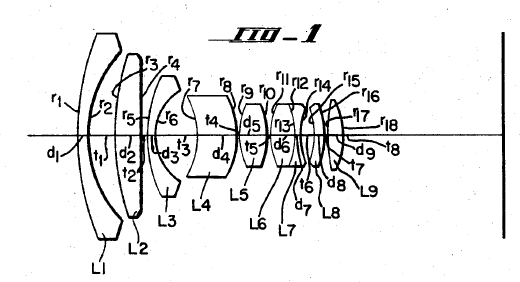
inventor: Yasuo Takahashi, Asahi Kogaku (patent number: 3545845)
Patent for Asahi Takumar 135/2.5 (version 1):
Takumar 135/2.5:
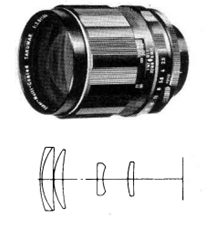
patented optical scheme:
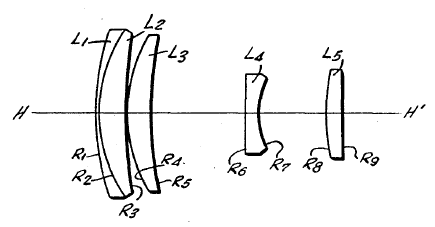
inventor: Yasuo Takahashi, Asahi Kogaku (patent number: 3459469)
Canon's copy-shop example #1
Asahi/Pentax 40/2.8 lens produced in 1976:

patent by Canon, 1978:
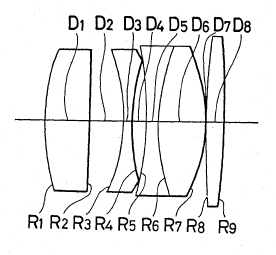

Canon's copy-shop example #2
Asahi 55/2.2 lens produced in 1957:

patent by Canon, 1958:
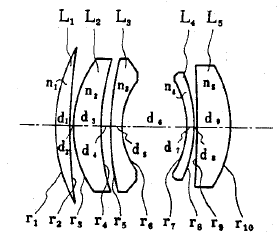
_________________
(almost) complete list of Helios lenses |
|
| Back to top |
|
 |
ChrisLilley


Joined: 01 Jan 2008
Posts: 1767
Location: Nice, France
|
 Posted: Sun Dec 06, 2009 2:13 pm Post subject: Posted: Sun Dec 06, 2009 2:13 pm Post subject: |
 |
|
ChrisLilley wrote:
Many thanks for the new set of drawings! Fascinating.
I guess the Nikkor 85/1.5 is the Nikkor-S 8.5cm f/1.5 rangefinder lens?
 
Would the Nikkor-S 5cm f/1.4 rangefinder lens also fall int he same category?
 
_________________
Camera (ˈkæ mə rə), n. Device for taking pictures in bright light
There are 10 kinds of people in the world: those who understand binary, and those who don’t. Key: Ai-P, Ai, Ai'ed, AiS
Camera: Nikon D90, D40, DK-21M eyepiece, ML-3 remote MF lenses: Nikkor 20mm f/4 K, AI'ed | N.K. Nikkor-N 24mm f/2.8 | Nikkor-N.C 24mm f/2.8 | Nikkor 28mm f/2.8 AiS late model | Арсенал (Arsenal) Мир-24Н (Mir-24N) 35mm f/2 | Cosina Voigtländer Ultron SL II 40mm f/2.0 | Micro-Nikkor 55mm f/2.8 AiS | Zoom-Nikkor 80-200 f/4.5 Ai | ЛЗОС (LZOS) Юпитер-9 (Jupiter-9) 85mm f/2 | Cosina Voigtländer APO-Lanthar 90mm f/3.5 SL | Nikkor-P 105mm f/2.5 pre-Ai, Ai'ed | Micro-Nikkor 105mm f/4 | Schneider Kreuznach Componon 105mm f/5.6 | Nikkor 135mm f/2.8, Ai'ed 1976 model | Nikkor 180mm f/2.8 ED AiS | Арсенал (Arsenal) ТЕЛЕАР-Н (Telear-n) 200mm f/3.5 | Nikkor 300 mm f/4.5 Ai (full equipment list) |
|
| Back to top |
|
 |
ChrisLilley


Joined: 01 Jan 2008
Posts: 1767
Location: Nice, France
|
 Posted: Sun Dec 06, 2009 2:23 pm Post subject: Posted: Sun Dec 06, 2009 2:23 pm Post subject: |
 |
|
ChrisLilley wrote:
Would this design fall into "Tele Takumar/ Enhanced Ernostar with 2 rear groups"? It looks just like your Tele Takumar/ Enhanced Ernostar category, with an additional rear element.
This is the Cosina Voigtländer APO-Lanthar 90mm f/3.5 SL

_________________
Camera (ˈkæ mə rə), n. Device for taking pictures in bright light
There are 10 kinds of people in the world: those who understand binary, and those who don’t. Key: Ai-P, Ai, Ai'ed, AiS
Camera: Nikon D90, D40, DK-21M eyepiece, ML-3 remote MF lenses: Nikkor 20mm f/4 K, AI'ed | N.K. Nikkor-N 24mm f/2.8 | Nikkor-N.C 24mm f/2.8 | Nikkor 28mm f/2.8 AiS late model | Арсенал (Arsenal) Мир-24Н (Mir-24N) 35mm f/2 | Cosina Voigtländer Ultron SL II 40mm f/2.0 | Micro-Nikkor 55mm f/2.8 AiS | Zoom-Nikkor 80-200 f/4.5 Ai | ЛЗОС (LZOS) Юпитер-9 (Jupiter-9) 85mm f/2 | Cosina Voigtländer APO-Lanthar 90mm f/3.5 SL | Nikkor-P 105mm f/2.5 pre-Ai, Ai'ed | Micro-Nikkor 105mm f/4 | Schneider Kreuznach Componon 105mm f/5.6 | Nikkor 135mm f/2.8, Ai'ed 1976 model | Nikkor 180mm f/2.8 ED AiS | Арсенал (Arsenal) ТЕЛЕАР-Н (Telear-n) 200mm f/3.5 | Nikkor 300 mm f/4.5 Ai (full equipment list) |
|
| Back to top |
|
 |
no-X


Joined: 19 Jul 2008
Posts: 2495
Location: Budejky, Czech Republic
|
 Posted: Sun Dec 06, 2009 2:28 pm Post subject: Posted: Sun Dec 06, 2009 2:28 pm Post subject: |
 |
|
no-X wrote:
| ChrisLilley wrote: |
| Would the Nikkor-S 5cm f/1.4 rangefinder lens also fall int he same category? |
Lovely Sonnars, both of them  I'll add them, too. I'll add them, too.
As for the Lanthar, I'm not sure. I don't have this lens. Is its optical block "fixed", or does the rear element stays in the same position during focusing?
_________________
(almost) complete list of Helios lenses |
|
| Back to top |
|
 |
ChrisLilley


Joined: 01 Jan 2008
Posts: 1767
Location: Nice, France
|
 Posted: Sun Dec 06, 2009 2:41 pm Post subject: Posted: Sun Dec 06, 2009 2:41 pm Post subject: |
 |
|
ChrisLilley wrote:
Does the Cosina Voigtländer Ultron 40mm f/2 fall into the Ultron group? It seems similar, but the second and third elements are different. 9also, the final element is aspherical).

_________________
Camera (ˈkæ mə rə), n. Device for taking pictures in bright light
There are 10 kinds of people in the world: those who understand binary, and those who don’t. Key: Ai-P, Ai, Ai'ed, AiS
Camera: Nikon D90, D40, DK-21M eyepiece, ML-3 remote MF lenses: Nikkor 20mm f/4 K, AI'ed | N.K. Nikkor-N 24mm f/2.8 | Nikkor-N.C 24mm f/2.8 | Nikkor 28mm f/2.8 AiS late model | Арсенал (Arsenal) Мир-24Н (Mir-24N) 35mm f/2 | Cosina Voigtländer Ultron SL II 40mm f/2.0 | Micro-Nikkor 55mm f/2.8 AiS | Zoom-Nikkor 80-200 f/4.5 Ai | ЛЗОС (LZOS) Юпитер-9 (Jupiter-9) 85mm f/2 | Cosina Voigtländer APO-Lanthar 90mm f/3.5 SL | Nikkor-P 105mm f/2.5 pre-Ai, Ai'ed | Micro-Nikkor 105mm f/4 | Schneider Kreuznach Componon 105mm f/5.6 | Nikkor 135mm f/2.8, Ai'ed 1976 model | Nikkor 180mm f/2.8 ED AiS | Арсенал (Arsenal) ТЕЛЕАР-Н (Telear-n) 200mm f/3.5 | Nikkor 300 mm f/4.5 Ai (full equipment list) |
|
| Back to top |
|
 |
no-X


Joined: 19 Jul 2008
Posts: 2495
Location: Budejky, Czech Republic
|
 Posted: Sun Dec 06, 2009 2:44 pm Post subject: Posted: Sun Dec 06, 2009 2:44 pm Post subject: |
 |
|
no-X wrote:
Yes, this is quite typical Ultron (basic Ultron: 1-1-1|2-1). I'd like to get this lens in M42 mount, but I have no luck...
_________________
(almost) complete list of Helios lenses |
|
| Back to top |
|
 |
ChrisLilley


Joined: 01 Jan 2008
Posts: 1767
Location: Nice, France
|
 Posted: Sun Dec 06, 2009 2:46 pm Post subject: Posted: Sun Dec 06, 2009 2:46 pm Post subject: |
 |
|
ChrisLilley wrote:
| no-X wrote: |
As for the Lanthar, I'm not sure. I don't have this lens. |
Okay. I do, so does Orio and Klaus.
| no-X wrote: |
| Is its optical block "fixed", or does the rear element stays in the same position during focusing? |
Its fixed (unit focusing). The whole block moves as one unit to focus.
_________________
Camera (ˈkæ mə rə), n. Device for taking pictures in bright light
There are 10 kinds of people in the world: those who understand binary, and those who don’t. Key: Ai-P, Ai, Ai'ed, AiS
Camera: Nikon D90, D40, DK-21M eyepiece, ML-3 remote MF lenses: Nikkor 20mm f/4 K, AI'ed | N.K. Nikkor-N 24mm f/2.8 | Nikkor-N.C 24mm f/2.8 | Nikkor 28mm f/2.8 AiS late model | Арсенал (Arsenal) Мир-24Н (Mir-24N) 35mm f/2 | Cosina Voigtländer Ultron SL II 40mm f/2.0 | Micro-Nikkor 55mm f/2.8 AiS | Zoom-Nikkor 80-200 f/4.5 Ai | ЛЗОС (LZOS) Юпитер-9 (Jupiter-9) 85mm f/2 | Cosina Voigtländer APO-Lanthar 90mm f/3.5 SL | Nikkor-P 105mm f/2.5 pre-Ai, Ai'ed | Micro-Nikkor 105mm f/4 | Schneider Kreuznach Componon 105mm f/5.6 | Nikkor 135mm f/2.8, Ai'ed 1976 model | Nikkor 180mm f/2.8 ED AiS | Арсенал (Arsenal) ТЕЛЕАР-Н (Telear-n) 200mm f/3.5 | Nikkor 300 mm f/4.5 Ai (full equipment list) |
|
| Back to top |
|
 |
no-X


Joined: 19 Jul 2008
Posts: 2495
Location: Budejky, Czech Republic
|
 Posted: Sun Dec 06, 2009 2:48 pm Post subject: Posted: Sun Dec 06, 2009 2:48 pm Post subject: |
 |
|
no-X wrote:
In this case I think it isn't possible to place it in any of these group. It's kind of "floating" desing (I don't know the exact term which should be used for this type of construction) like the Macro 125/2.5...
_________________
(almost) complete list of Helios lenses |
|
| Back to top |
|
 |
ChrisLilley


Joined: 01 Jan 2008
Posts: 1767
Location: Nice, France
|
 Posted: Sun Dec 06, 2009 2:57 pm Post subject: Posted: Sun Dec 06, 2009 2:57 pm Post subject: |
 |
|
ChrisLilley wrote:
And this would fall under "Ultron with 7 elements"? Cosina Voigtländer Nokton 58mm f/1.4 SL2

_________________
Camera (ˈkæ mə rə), n. Device for taking pictures in bright light
There are 10 kinds of people in the world: those who understand binary, and those who don’t. Key: Ai-P, Ai, Ai'ed, AiS
Camera: Nikon D90, D40, DK-21M eyepiece, ML-3 remote MF lenses: Nikkor 20mm f/4 K, AI'ed | N.K. Nikkor-N 24mm f/2.8 | Nikkor-N.C 24mm f/2.8 | Nikkor 28mm f/2.8 AiS late model | Арсенал (Arsenal) Мир-24Н (Mir-24N) 35mm f/2 | Cosina Voigtländer Ultron SL II 40mm f/2.0 | Micro-Nikkor 55mm f/2.8 AiS | Zoom-Nikkor 80-200 f/4.5 Ai | ЛЗОС (LZOS) Юпитер-9 (Jupiter-9) 85mm f/2 | Cosina Voigtländer APO-Lanthar 90mm f/3.5 SL | Nikkor-P 105mm f/2.5 pre-Ai, Ai'ed | Micro-Nikkor 105mm f/4 | Schneider Kreuznach Componon 105mm f/5.6 | Nikkor 135mm f/2.8, Ai'ed 1976 model | Nikkor 180mm f/2.8 ED AiS | Арсенал (Arsenal) ТЕЛЕАР-Н (Telear-n) 200mm f/3.5 | Nikkor 300 mm f/4.5 Ai (full equipment list) |
|
| Back to top |
|
 |
ChrisLilley


Joined: 01 Jan 2008
Posts: 1767
Location: Nice, France
|
 Posted: Sun Dec 06, 2009 2:59 pm Post subject: Posted: Sun Dec 06, 2009 2:59 pm Post subject: |
 |
|
ChrisLilley wrote:
| no-X wrote: |
| In this case I think it isn't possible to place it in any of these group. It's kind of "floating" desing (I don't know the exact term which should be used for this type of construction) like the Macro 125/2.5... |
No, nothing floats. All optical elements move forwards, by the same amount, as you focus closer. That's what I meant by "unit focusing". This is also shown by the fact that the focal length at closest focus is the same as at infinity.
_________________
Camera (ˈkæ mə rə), n. Device for taking pictures in bright light
There are 10 kinds of people in the world: those who understand binary, and those who don’t. Key: Ai-P, Ai, Ai'ed, AiS
Camera: Nikon D90, D40, DK-21M eyepiece, ML-3 remote MF lenses: Nikkor 20mm f/4 K, AI'ed | N.K. Nikkor-N 24mm f/2.8 | Nikkor-N.C 24mm f/2.8 | Nikkor 28mm f/2.8 AiS late model | Арсенал (Arsenal) Мир-24Н (Mir-24N) 35mm f/2 | Cosina Voigtländer Ultron SL II 40mm f/2.0 | Micro-Nikkor 55mm f/2.8 AiS | Zoom-Nikkor 80-200 f/4.5 Ai | ЛЗОС (LZOS) Юпитер-9 (Jupiter-9) 85mm f/2 | Cosina Voigtländer APO-Lanthar 90mm f/3.5 SL | Nikkor-P 105mm f/2.5 pre-Ai, Ai'ed | Micro-Nikkor 105mm f/4 | Schneider Kreuznach Componon 105mm f/5.6 | Nikkor 135mm f/2.8, Ai'ed 1976 model | Nikkor 180mm f/2.8 ED AiS | Арсенал (Arsenal) ТЕЛЕАР-Н (Telear-n) 200mm f/3.5 | Nikkor 300 mm f/4.5 Ai (full equipment list) |
|
| Back to top |
|
 |
Spotmatic


Joined: 18 Aug 2008
Posts: 4045
Location: Netherlands
|
 Posted: Sun Dec 06, 2009 3:00 pm Post subject: Posted: Sun Dec 06, 2009 3:00 pm Post subject: |
 |
|
Spotmatic wrote:
Maybe a few Komura lenses can also be added, because of their Ernostar design?
See also: http://forum.mflenses.com/komura-fast-100-105-and-135mm-lenses-king-of-ernostar-t20547.html
And a diagram of the 105mm f/2 Komura:

_________________
Peter - Moderator
Pentax K-5 + Pentax 645 + Canon 5D + Bessa RF 10,5cm Heliar, and a 'little' bag full of MF lenses. The lens list is * here *.
My fast 80s: Asahi-Kogaku Takumar 83mm f/1.9 - Super-Takumar 85mm f/1.9 - FA 77mm f/1.8 Limited - Cyclop 85/1.5 (Helios-40 innards) - Komura 80mm f/1.8 - Meyer Görlitz Primoplan 7,5cm 1:1.9 - Carl Zeiss Jena 80mm f/1.8 Pancolar - Canon 85mm f/1.8 S.S.C. - Canon 85mm f/1.2 S.S.C. Aspherical |
|
| Back to top |
|
 |
ChrisLilley


Joined: 01 Jan 2008
Posts: 1767
Location: Nice, France
|
 Posted: Sun Dec 06, 2009 3:21 pm Post subject: Posted: Sun Dec 06, 2009 3:21 pm Post subject: |
 |
|
ChrisLilley wrote:
Is this design derived from a triplet? It seems to be, the first and third elements being replaced by doublets while retaining the predominantly convex character in each case.
But I can't slot it into one of your existing categories. Does it have a name?
This is the Micro-Nikkor 105mm f/4, which was originally derived from a "short mount" bellows lens. There are no floating elements or CRC.
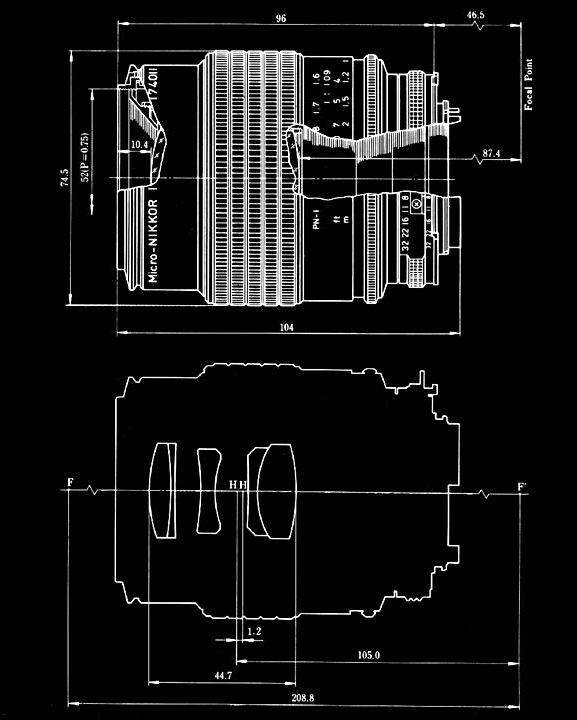
_________________
Camera (ˈkæ mə rə), n. Device for taking pictures in bright light
There are 10 kinds of people in the world: those who understand binary, and those who don’t. Key: Ai-P, Ai, Ai'ed, AiS
Camera: Nikon D90, D40, DK-21M eyepiece, ML-3 remote MF lenses: Nikkor 20mm f/4 K, AI'ed | N.K. Nikkor-N 24mm f/2.8 | Nikkor-N.C 24mm f/2.8 | Nikkor 28mm f/2.8 AiS late model | Арсенал (Arsenal) Мир-24Н (Mir-24N) 35mm f/2 | Cosina Voigtländer Ultron SL II 40mm f/2.0 | Micro-Nikkor 55mm f/2.8 AiS | Zoom-Nikkor 80-200 f/4.5 Ai | ЛЗОС (LZOS) Юпитер-9 (Jupiter-9) 85mm f/2 | Cosina Voigtländer APO-Lanthar 90mm f/3.5 SL | Nikkor-P 105mm f/2.5 pre-Ai, Ai'ed | Micro-Nikkor 105mm f/4 | Schneider Kreuznach Componon 105mm f/5.6 | Nikkor 135mm f/2.8, Ai'ed 1976 model | Nikkor 180mm f/2.8 ED AiS | Арсенал (Arsenal) ТЕЛЕАР-Н (Telear-n) 200mm f/3.5 | Nikkor 300 mm f/4.5 Ai (full equipment list) |
|
| Back to top |
|
 |
no-X


Joined: 19 Jul 2008
Posts: 2495
Location: Budejky, Czech Republic
|
 Posted: Sun Dec 06, 2009 6:26 pm Post subject: Posted: Sun Dec 06, 2009 6:26 pm Post subject: |
 |
|
no-X wrote:
| ChrisLilley wrote: |
| no-X wrote: |
| In this case I think it isn't possible to place it in any of these group. It's kind of "floating" desing (I don't know the exact term which should be used for this type of construction) like the Macro 125/2.5... |
No, nothing floats. All optical elements move forwards, by the same amount, as you focus closer. That's what I meant by "unit focusing". This is also shown by the fact that the focal length at closest focus is the same as at infinity. |
Sorry, my bad. It could be (tele-)ultron then 
Spotmatic: This komura is already present in Primoplan category (Primoplan is version of Ernostar with doublet instead of 2nd element).
ChrisLilley: The Micro Nikkor is Heliar (Heliar is 2-1-2)
Relayer: The Tamron 200/3.5 reminds me some Takumars/Pentax lenses. It doesn't fit to any category - it's quite modified Ernostar
The 135/3.2 Hexanon is similar to some Nikkors. It's Ernostar-based, but i have no category for this particular version.
As for the Fujinons: I'd add the 100/2.8 to enhanced Ernostar category. Orientation of the reat doublet likely doesn't change a much, I've seen many patents showing both positions are possible - results should be very similar.
55/2.2 - 4 elements in 4 groups - I think it could be basic Ernostar. I'm not sure if simple gauss configuration using only 4 elements could be that fast (and perform acceptably).
_________________
(almost) complete list of Helios lenses |
|
| Back to top |
|
 |
dakoo


Joined: 08 Mar 2008
Posts: 603
|
 Posted: Sun Dec 06, 2009 6:34 pm Post subject: Posted: Sun Dec 06, 2009 6:34 pm Post subject: |
 |
|
dakoo wrote:
This is one of the most educative threads on our forum, (or maybe now i am able to understand it  ) Thanks a lot guys. ) Thanks a lot guys.
This could be make STICKY.
_________________
Yashica ML 2.4/24, ML 2.4./28,
Zeiss Distagon 35/1.4, Planer 1.4/50, Planer 1.7/50,
SMC Tak 1.4/50,Tessar 2.8/50, Jupiter2/85
CZJ 4/135; Pentacon 4/200
Canon Tns 24/3.5
|
|
| Back to top |
|
 |
Spotmatic


Joined: 18 Aug 2008
Posts: 4045
Location: Netherlands
|
 Posted: Sun Dec 06, 2009 7:03 pm Post subject: Posted: Sun Dec 06, 2009 7:03 pm Post subject: |
 |
|
Spotmatic wrote:
| no-X wrote: |
Spotmatic: This komura is already present in Primoplan category (Primoplan is version of Ernostar with doublet instead of 2nd element).
|
Indeed! I was still looking at the first version, on my HDD. I have downloaded your updated version.
Maybe you can also create PDF versions? This way we'll be able to search through the lens names (unless the original is a picture too, in which case that wouldn't work).
_________________
Peter - Moderator
Pentax K-5 + Pentax 645 + Canon 5D + Bessa RF 10,5cm Heliar, and a 'little' bag full of MF lenses. The lens list is * here *.
My fast 80s: Asahi-Kogaku Takumar 83mm f/1.9 - Super-Takumar 85mm f/1.9 - FA 77mm f/1.8 Limited - Cyclop 85/1.5 (Helios-40 innards) - Komura 80mm f/1.8 - Meyer Görlitz Primoplan 7,5cm 1:1.9 - Carl Zeiss Jena 80mm f/1.8 Pancolar - Canon 85mm f/1.8 S.S.C. - Canon 85mm f/1.2 S.S.C. Aspherical |
|
| Back to top |
|
 |
no-X


Joined: 19 Jul 2008
Posts: 2495
Location: Budejky, Czech Republic
|
 Posted: Sun Dec 06, 2009 7:14 pm Post subject: Posted: Sun Dec 06, 2009 7:14 pm Post subject: |
 |
|
no-X wrote:
I'll prepare PDF version (it's possible, but I tried it and browsing is slower than viewing the PNG picture) after I add all mentioned info.
_________________
(almost) complete list of Helios lenses |
|
| Back to top |
|
 |
poilu

Joined: 26 Aug 2007
Posts: 10472
Location: Greece
Expire: 2019-08-29
|
 Posted: Sun Dec 06, 2009 7:17 pm Post subject: Posted: Sun Dec 06, 2009 7:17 pm Post subject: |
 |
|
poilu wrote:
| dakoo wrote: |
This is one of the most educative threads on our forum, (or maybe now i am able to understand it  ) Thanks a lot guys. ) Thanks a lot guys.
This could be make STICKY. |
+1000 |
|
| Back to top |
|
 |
bob955i

Joined: 15 Apr 2007
Posts: 2495
|
 Posted: Sun Dec 06, 2009 7:23 pm Post subject: Posted: Sun Dec 06, 2009 7:23 pm Post subject: |
 |
|
bob955i wrote:
Stickied. |
|
| Back to top |
|
 |
aoleg


Joined: 22 Feb 2008
Posts: 1387
Location: Berlin, DE
|
 Posted: Sun Dec 06, 2009 9:02 pm Post subject: Posted: Sun Dec 06, 2009 9:02 pm Post subject: |
 |
|
aoleg wrote:
| cooltouch wrote: |
| I suppose I should mention this: I've recently been going through some of my old collections of photo-related publications, and I have some items that members here might find interesting. |
I have never seen an optical diagram to Micro Nikkor 105/2.8 (Ai-S). Do you have one? 
_________________
List of lenses |
|
| Back to top |
|
 |
Seele

Joined: 17 Apr 2009
Posts: 742
Location: Sydney Australia
|
 Posted: Wed Dec 09, 2009 3:09 pm Post subject: Posted: Wed Dec 09, 2009 3:09 pm Post subject: |
 |
|
Seele wrote:
no-X,
I have been dipping in at this thread for a little while.
In his book "Optics", later "Photographic Optics", Arthur Cox had done a lot of work tracing the developments of each type of lens; I think it would be helpful to use his work as an additional reference.
You would be most welcomed if you want to consider my way of looking at it as another way of considering the various divergence in development. Here I'll have a go at the triplet:
Our foundation: the Cooke Triplet by Harold Dennis Taylor; first with the front two elements very close together, later the elements were arranged with a somewhat more balanced spacing.
First divergence: Aldis Uno Anastigmat: a reversion to its former configuration and taken to extreme, where the two front elements are cemented into a doublet, making for a 2:1 scheme.
Development method one: replacing each element with a cemented doublet:
Rear element replaced by a doublet: classic Tessar type, even though its genesis was a combination of an Unar front with a Protar back, making it 1-1:2.
Variation: placing the diaphragm behind the front element making it 1:1-2 as in Elmar.
I do not recall off-hand any lens with the front element replaced by a doublet.
Middle element replaced by a doublet: another type of Hektor.
Both front and back elements replaced by doublets:
Version 1: positive on the outside: Original Heliar.
Version 2: negative on the outside: Dynar, later renamed Heliar.
All three elements replaced by doublets: Hektor (and also the Dallmeyer Triple Achromatic designed way before the Cooke Triplet).
Development method two: replacing each element with a pair of lenses.
Front element replaced by a pair of lenses: Kern Kino-Objektiv.
Rear element replaced by a pair of lenses: Taylor-Hobson Speedic and Coric.
Middle element replaced by a pair of lenses: Taylor-Hobson Aviar. This makes the lens symmetrical and closer to the Double-Gauss type. In the Aviar the two negatives are placed very close to each side of the diaphragm, then the Dogmar type makes them pulled further apart.
I hope you follow my line of thought. |
|
| Back to top |
|
 |
francotirador


Joined: 17 Sep 2009
Posts: 894
|
 Posted: Thu Dec 10, 2009 3:23 am Post subject: Posted: Thu Dec 10, 2009 3:23 am Post subject: |
 |
|
francotirador wrote:
End of my doubts. Great job.
Thanks. 
_________________
Canon 5D II-Sony nex 6
Canon L 80-200 f 2.8 - Canon L 135 f2 - Canon FD 135/2.5 convert to EOS - Yashica 50 1.4 ML - Canon FD 50 1.2 - Distagon 35mm 2.8 T AEJ - Minolta MC 24mm f 2.8 - Canon LTM 85 1.9- Canon LTM 85mm 1.9 convert to EOS - Rodenstock Heligon 50 1.9 - Color Skopar 50 2.8 & MAte Box & filters 4X4
Contax RTS II y Minolta SRT 303 - 28-135 3.6 Tokina - Minolta MD 45 f2.0 - Minolta Zoom 80 200 4.5 (Leica)
www.isgleasphoto.com
The life is more easy with this forum .... |
|
| Back to top |
|
 |
no-X


Joined: 19 Jul 2008
Posts: 2495
Location: Budejky, Czech Republic
|
|
| Back to top |
|
 |
aoleg


Joined: 22 Feb 2008
Posts: 1387
Location: Berlin, DE
|
 Posted: Mon Jan 11, 2010 3:28 am Post subject: Posted: Mon Jan 11, 2010 3:28 am Post subject: |
 |
|
aoleg wrote:
Kaleinar-5N 100/2.8 (an Ernostar/Sonnar type):
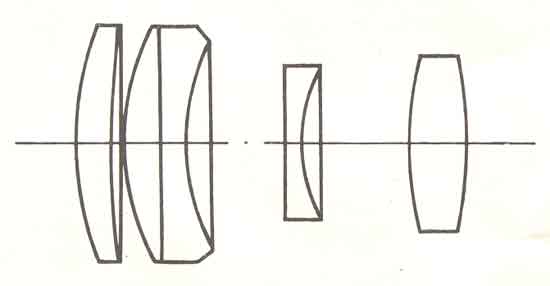
_________________
List of lenses |
|
| Back to top |
|
 |
|
|
